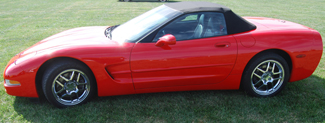 “Still eliciting the passion of bargain-minded speed fiends, the Chevrolet Corvette delivers power, handling and style at a relatively reasonable price,” said Motor Trend magazine in its October 1999 “Complete Buyer’s Guide 2000 & 2001 New Cars” issue. Offered again for the New Millennium were three models powered by the marvelous LS1 V-8 and suited to a wide range of buyer needs from a luxury touring machine to a street-performance car.
“Still eliciting the passion of bargain-minded speed fiends, the Chevrolet Corvette delivers power, handling and style at a relatively reasonable price,” said Motor Trend magazine in its October 1999 “Complete Buyer’s Guide 2000 & 2001 New Cars” issue. Offered again for the New Millennium were three models powered by the marvelous LS1 V-8 and suited to a wide range of buyer needs from a luxury touring machine to a street-performance car.As in 1999, the fixed-roof hardtop was the “loss leader” from a pricing and marketing standpoint, though it represented a stripped-for-high-performance model from the enthusiast’s view. The Goodyear Eagle F1 tires (P245/45ZR17 front and P275/40ZR18 rear) and an upgraded type Z51 Performance Handling suspension package were offered with this unique-looking body style, which had quickly become the most popular offering in the Corvette model line up.
A coupe and a convertible remained available, too. New exterior and interior color options were the main changes in 2000 models. The fixed-roof hardtop had a base price of $39,475 and 18,113 were built. The hatchback’s original price was $38,900 and Chevy turned out only a mere 2,090 of them. The Corvette convertible listed for $45,900 and had a 13,479-unit production run. All three models rode on a 105-5-in. wheelbase and stretched 179.7 in. end to end.
A new five-spoke aluminum wheel was released and an optional polished version was available. Standard equipment included next-generation dual airbags, air conditioning, leather seating, power door locks and windows, a PassKey II theft-deterrent system, electronic speed control, an electronic Driver Information Center and Remote Function Actuation with Remote Keyless Entry.
For collectors interested in “matching numbers,” 2000 Corvettes were numbered 1G1YY[1/2/3]2G5Y5100000 to 1G1YY[1/2/3]2G5Y5133682. The first symbol 1 indicates U.S. Built. The second symbol G indicates a GM product. The third symbol 1 indicates Chevrolet Motor Div. The fourth and fifth symbols YY indicate Corvette. The sixth symbol indicates body style: 1=fixed-roof hardtop, 2=two-door coupe and 3=two-door convertible. The seventh symbol indicates restraint code: 2=Active manual belts with driver and front passenger inflatable restraint system. The eighth symbol indicates engine: G=RPO LS1 5.7-liter Sequential multi-port fuel-injection (MFI) Chevrolet V-8. The ninth symbol is a check digit. The 10th symbol Y=2000. The 11th symbol 5=Bowling Green, Kentucky plant. The last six symbols indicate the sequential production number.
The LS1 V-8 was used in all 2000 Corvettes and there really was no need for any performance option. With a 3.90 x 3.62 in. bore and stroke, this modern, high-tech power plant displaced 346 cubic inches and cranked up 345 hp at 5600 rpm. Its sequential fuel injection fed the cylinders plenty of vitamins and minerals.
Total Model-year production amounted to 33,682 Corvettes and 3,578 cars left the Kentucky factory with optional Millennium Yellow paint in honor of the Y2K year. It was available on the coupe and convertible only for $500 extra.
In sports car racing in 2000, the C5-R Corvette proved itself to be a winner. Early in the year, in Florida, the 48th Annual Super Flow 12 Hours at Sebring race was held and C5-R Corvette No. 4, driven by Ron Fellows, Chris Kneifel and Justin Bell, placed 16th overall. C5-R Corvette No. 3, driven by Andy Pilgrim, Kelly Collins and Frank Freon followed up with a 24th overall finish. In March, General Motors took the wraps off a Corvette Pace Car for the 24 Hours of Le Mans and displayed this car at the Chevy/Vette Fest in Chicago.
By that time, it had become clear that it was only a matter of time before the Corvette would be making national and international racing headlines. The big day came on June 17, 2000 when “America’s Sports Car” took on the best competitors in the world at Le Mans. By the time France’s famous 24-hour endurance race was over, the C5-R had surprised more than a few skeptics with an impressive finish. The Corvettes came in third and fourth in their class.
The C5-R racing cars that attacked Le Mans' Mulsanne Corner did so with many of the same parts found in the production car, including its aerodynamic styling, rigid body structure and tremendous suspension geometry. Even the racing engine was derived from the production car's LS1 power plant. Modifications upped the engine’s output to an amazing 620 hp.
On May 4, 2000, the “Speedvision” cable television program introduced its "Corvette—The American Dream" series. Later, at Lowe's Motor Speedway in Charlotte, Round One of the Speedvision GT Championship was held. Bill Cooper, driving the Les Stanford/Pirate Racing Corvette C5, won the race. MTI Racing's Corvette C5, driven by Reese Cox, took second place.
Our featured car is a Torch Red (Code 79U) convertible with Illinois license plates photographed at the 2010 Corvette Funfest at Mid America Motorworks in Effingham, Ill. Other colors available were Artic White (10U), Light Pewter Metallic (11U), Sebring Silver Metallic (13U), Nassau Blue Metallic (23U), Navy Blue Metallic (28U), Black (41U), Millennium Yellow Clear Coat (79U), Magnetic Red II Clear Coat (86U) and Dark Bowling Green Metallic (91U).